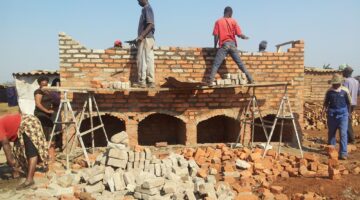




Dzivarasekwa Slum Upgrading Project, Zimbabwe
Main objectives of the project
The Dzivarasekwa Slum Upgrading Project, situated in Dzivarasekwa Extension, is a significant component of the broader Harare Slum Upgrading Project. Spearheaded by the Zimbabwe Homeless People's Federation and the Dialogue on Shelter for the Homeless Trust, in collaboration with the City of Harare and the central government, this initiative marks the first instance of city authorities partnering directly with slum communities in such a manner. This innovative partnership model empowers residents to actively participate in all aspects of the upgrading process, ensuring that improvements align closely with their needs and priorities. Additionally, residents receive training across various fields, including construction, fostering skills development and community involvement. Commencing in 2011, construction efforts remain ongoing, with 480 families poised to benefit as primary recipients of land for housing development, leading to enhanced tenure security and the provision of essential services such as water and sanitation facilities.
Date
- 2011: Rehabilitación
Stakeholders
- Promotor: City of Harare
- Promotor: Zimbabwe Homeless People’s Federation
- Promotor: Dialogue on Shelter for the Homeless in Zimbabwe Trust
- Bill and Melinda Gates Foundation
- Slum Dwellers International (SDI)
- Selavip Foundation
Location
Country/Region: Harare, Zimbabwe
Description
Following independence in 1980, Zimbabwe witnessed a significant influx of rural residents migrating to urban areas, resulting in the rapid proliferation of slums throughout major towns and cities. However, the lack of housing development exacerbated this issue. In response, the government launched a nationwide slum clearance campaign in 2005, displacing thousands and demolishing their homes. During this campaign, slum dwellers were relocated to holding camps, including the one in Dzivarasekwa Extension in Harare, where basic services were lacking. Two years later, the government allocated land to upgrade the settlement, aiming to prevent further eviction and displacement. In 2010, a memorandum of understanding was signed between the Dialogue on Shelter for the Homeless in Zimbabwe Trust, Zimbabwe Homeless People’s Federation, and the City of Harare, focusing on city-wide slum upgrading initiatives, marking a radical shift in approach where city authorities collaborated directly with slum communities.
The Dzivarasekwa project aimed to enhance living conditions for residents, promote inclusive local government practices, and serve as a model for upgrading other slums under the Harare Slum Upgrading Project (HSUP). The project's implementation involved distinct roles for various organizations. The Dialogue on Shelter for the Homeless in Zimbabwe Trust and the Zimbabwe Homeless People’s Federation were responsible for documentation, labor provision, community mobilization, and construction, while the City of Harare oversaw infrastructure installation, technical expertise provision, and project supervision. A project management committee, comprising community, alliance, and city representatives, supervised the upgrade project. Funding for the project was sourced from savings by beneficiaries, waivers from the City of Harare, and contributions from partners like the Selavip Foundation, SDI, DFID, and the Bill and Melinda Gates Foundation.
Community engagement was integral to every phase of the Dzivarasekwa initiative to ensure improvements aligned with residents’ needs. Community members participated in data collection, mapping, inventorying, service upgrading, and housing planning and construction. Architectural designs for new homes were developed through community consultations, leading to the adoption of a semi-detached design to reduce construction costs. Residents contributed to trench digging, pipe laying, and house building, while artisan training programs produced teams of plumbers and bricklayers. Housing beneficiaries were selected based on household employment status and income, with priority given to vulnerable households led by children, elderly, or women. The average cost per 24 square meter house was $2,400 USD, financed through resident loans from savings groups.
Since commencement in 2011, approximately 2,050 residents have obtained secure land tenure, 336 homes have been constructed, and 1,344 people have been housed. Sanitation facilities have been upgraded, solar-powered water and lighting systems installed, and roads tarred. Slums like Dzivarasekwa are now recognized as integral parts of the city, aligning with its broader development agenda. This integration fosters community inclusion and secures housing rights and access to basic services. The project contributed to the formulation of the Harare Slum Upgrading Strategy in 2012, enhancing residents' understanding of city processes, rights, and obligations. This initiative established a precedent for constructive engagement between local authorities and slum communities, contrasting previous adversarial relations marked by evictions and demolitions. Lessons learned from the Dzivarasekwa project are being applied in other HSUP initiatives across Harare and beyond, such as in Masvingo, where the city council has supported the construction of 1,000 eco-san toilets.

